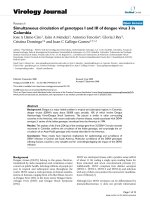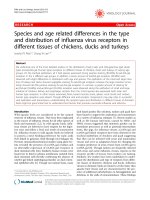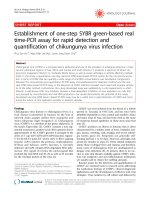Molecular insights into neutralization and enhancement of dengue virus infection in monocytes
Bạn đang xem bản rút gọn của tài liệu. Xem và tải ngay bản đầy đủ của tài liệu tại đây (5.05 MB, 222 trang )
MOLECULAR INSIGHTS INTO NEUTRALIZATION
AND ENHANCEMENT OF DENGUE VIRUS INFECTION
IN MONOCYTES
CHAN KUAN RONG
B.Science (Hons), NUS
A THESIS SUBMITTED FOR THE DEGREE OF
DOCTOR PHILOSOPHY
NUS Graduate School for Integrative Sciences and Engineering
National University of Singapore
2012
i
07/03/2013
i
Acknowledgements
I would like to express my heartfelt gratitude to Associate Professor Ooi Eng Eong for
his patient guidance, advice and encouragement throughout my research. His
continued support and mentorship significantly aided the progress of the project. I
would also like to thank Professor Mariano Garcia-Blanco for his kind encouragement
and suggestions.
My sincere appreciation is extended to my thesis advisory committee, Professor Chan
Soh Ha, Associate Professor Subhash Vasudevan and Dr. Justin Wong for the
stimulating discussions and critical suggestions during my research.
Special thanks to Tan Hwee Cheng, Summer Zhang, Eugenia Ong, Tanu Chawla,
Ryan Wu, Dr. Brendon Hanson, Angeline Lim, Nivashini Kaliaperumal, Zhang Qian
and Angelia Chow for providing technical assistance and support in my research. And
not forgetting colleagues from Duke-NUS who have made this a very conducive
environment for research.
Lastly, I would like to thank my family and friends for their encouragement all these
years. I am glad to be able to share my successes and failures with them.
ii
Table of contents
Acknowledgements …..……………………………………………………...…………. i
Table of contents …………………………….………………………….….……….…. ii
Summary …....……..………………………...………….…………………...…….…...viii
List of tables …………………………………………………………………………… x
List of figures ………………………………………………………………………….. xi
List of abbreviations ………………………………………………………..……….… xvi
List of publications ……………………………………………………………………. xx
Chapter 1: Introduction
1.1
Dengue …….…………………...…………………………............................. 2
1.1.1 Dengue epidemiology ………………………………………………… 2
1.1.2 Clinical presentation and progression …………………………………. 7
1.1.3 Relationship between disease pathogenesis and immunity ……………. 11
1.2
Dengue virus structure and genome..….……………….………….…………. 12
1.3
Prevention and control of dengue ……………….………………………..……..15
1.3.1
Limitations in vector control programs………………………………... 15
1.3.2 Vaccines in clinical development ……………………………………….18
Chimeric vaccines …………………………………………………..…..
18
19
Live attenuated vaccines ………………………………….…...………..
iii
Sub-unit vaccines and nucleic acid vaccines ………………………..… 20
1.3.3
1.4
Challenges in dengue vaccine development ………………….………...24
Immune responses and their consequences to dengue infection……………… 28
1.4.1 Antibody responses in protection and pathogenesis …….…...……….....28
Protective antibody responses……………………………………..….....
30
Antibody responses in dengue pathogenesis ………………………..…. 33
1.4.2 T-cell responses in protection and pathogenesis ………………………..34
Protective T-cell responses ……………………………..….......……….34
T-cell responses in dengue pathogenesis …………...……………..…....34
1.4.3 Cytokine responses involved in pathogenesis …………..……….……...36
1.5
Molecular insights of Dengue infection ……..…………………………….….. 39
1.5.1
Dengue life cycle ……………….………….………………….……….. 39
1.5.2 Subversion of innate immunity to establish infection in monocytes…….42
1.6
Molecular insights of neutralization and enhancement of DENV infection .…...45
1.6.1
The role of FcγR DENV neutralization …………………………….… 45
1.6.2
The role of FcγR in ADE of dengue infection ………………………... 50
1.6.3 Does ADE of DENV infection suppress innate immune responses? .......50
1.7
Gaps in knowledge in DENV neutralization and ADE….................................. 54
iv
Chapter 2: Methods
2.1
Cells …………………..………….……………...……………………….......…
57
2.2
THP-1 subclones …………….…….…….……...……….……………….....…..
58
2.3
Antibodies …….……………….…….………...………………..........................
58
2.4
Human sera…………….………………...……………….…………….………..
60
2.5
Viruses …….……………….…………...…………………………………….....
60
2.6
Affinity measurements by indirect ELISA .…………….….…….………...........
61
2.7
Plaque assay …….……………………….……………………………...…........
61
2.8
Plaque reduction neutralization test……….…….…………...………………….
62
2.9
Virus infection in THP-1 cells ..…………….………...…………..…….….......
62
2.10
Real-time PCR …………….….……………...……………..……….………….
62
2.11
Fluorescent labeling of viruses …………………….....………….………......…
63
2.12
Visualization and quantification of DiD-virus uptake ………….……………...
63
2.13
Sucrose gradient analysis of DENV immune complex sizes …………….…….
64
2.14
Western blot ………….………………………….……………………..……….
65
2.15
Immunoprecipitation ……….…...…………………………………………........
65
2.16
siRNA transfection of THP-1 and K562 .…………….….…….…......................
66
2.17
Overexpression in THP-1..……………..……...………….………………..........
66
2.18
Receptor blocking studies ……….…….………...………………….……….….
66
v
2.19
Assessing surface monocytic marker expression ...……………..………….....
66
2.20
Microarray analysis…….….……………...……….……….…….…..…….….
67
2.21
Interferon and drug treatment ……………………........………….…..........…..
68
2.22
Co-immunoprecipitation ………….…….…………………………......………
68
2.23
ELISA to assess LILRB1 binding to DENV…………………………………… 69
2.24
Statistical analysis …………….………………………………………..………
69
Chapter 3: Results
3.1
Early interactions in antibody-mediated neutralization of dengue virus
3.1.1
Homologous DENV serotypes are neutralized despite FcγR-mediated
uptake but heterologous DENV serotypes are neutralized only when
57
73
FcγR-mediated uptake is inhibted………………….……………..
57
3.1.2
Increasing antibody concentrations inhibits FcγR-mediated uptake of
immune complexes …………………………………………………….
3.1.3
58
82
Size of DENV immune complex is dependent on the concentration of 58
antibody.………………………………………………………………... 86
58
3.1.4
Aggregation of DENV enables antibodies to cross-link the inhibitory 22
FcγRIIB.…………………………….…………………………………...
3.1.5
90
25
Dengue neutralization in the presence of phagocytosis distinguishes
26
serotype-specific from cross-neutralizing antibodies with better
accuracy than PRNT…………………………………………………….. 28
95
vi
31
32
3.2
The use of FcγR in DENV neutralization
3.2.1
FcγRI ligation is required for uptake of neutralized DENV immune
complexes……………………………………………………………….. 103
3.2.2
FcγR-mediated phagocytosis following FcγRIIB knockdown…………. 106
3.2.3
Preferential engagement of FcγRI in monocytes results in
neutralization of DENV immune complexes………………………….... 108
3.3
Regulators of FcγR-signalling in antibody-dependent enhancement of dengue
infection
3.3.1
Isolation of two THP-1 subclones with increased uptake of dengue
immune complexes……………………………………………………... 115
3.3.2
Two subclones of THP-1 with differential susceptibility to antibodydependent enhancement of dengue infection………………………..…. 120
3.3.3
IFN signaling pathway contributes minimally to ISG induction…….… 123
3.3.4 ISG induction following ADE of DENV infection is Syk-dependent….. 126
3.3.5
ISG induction following ADE of DENV infection can be attenuated by
increased SHP-1 phosphorylation………………………………………
3.3.6
128
Antibody opsonised DENV co-ligates LILRB1 with activating FcR
for enhanced DENV replication……………………………………….... 131
vii
54
Chapter 4: Discussion
4.1
Preface………………………………………………………………………...... 138
4.2
Viral aggregates co-ligate inhibitory receptor FcγRIIB to inhibit uptake of
dengue immune complexes…………………………………………………...
4.3
139
Assessment of FcγR-mediated phagocytosis to distinguish protective humoral
immunity from cross-reactive immune response………………………….…… 143
4.4
Preferential engagement of FcγRI during dengue neutralization results in
uptake and neutralization of dengue immune complexes………………………. 145
4.5
LILRB1 in ADE of dengue infection……………………………………..…….. 147
4.6
Concluding remarks…………………………………………….……………… 151
Bibliography ………..…………………………………………………...……………. 153
Appendices …………………………………………………………………………….. 190
viii
Summary
Dengue virus (DENV) continues to put billions at risk of life-threatening disease
annually and is the most prevalent mosquito-borne viral disease. However, no
licensed dengue vaccine or drug is currently available. The underlying problem
resides in the humoral response to DENV where immunity generated protects only
against the serotype that caused the infection. On the other hand, cross-protection
against the other three heterologous DENV serotypes is only transient, lasting for 2-3
months. Moreover, subsequent infections with a different DENV serotype may result
in increased risk of dengue haemorrhagic fever or dengue shock syndrome. One of the
leading hypotheses to explain for this increased viraemia and disease severity during
secondary infection is antibody-dependent enhancement (ADE), where nonneutralizing antibodies or waning antibody titers can form dengue immune complexes
which interact with fragment crystallisable receptors (FcγR) expressed in monocytes
to result in enhanced uptake and infection. Hence, defining the determinants of
successful virus neutralization and enhancement of dengue infection would be
important in the design of an effective dengue vaccine that protects against all four
DENV serotypes while minimizing the risk of ADE of DENV infection. Using
fluorescent labelled DENV, we examined the early intracellular events of antibodyopsonized DENV following interaction with human acute monocytic leukemia cells
(THP-1) to understand how virus-antibody complexes are neutralized in human
monocytes. We found that at neutralizing antibody concentrations, antibody
concentration affects the size of the immune complexes formed, which results in the
co-ligation of different FcγR. Larger immune complexes appear to cross-link FcγRIIB,
which recruits phosphatidylinositol 3,4,5-trisphosphate 5 phosphatase-1 (SHIP-1) and
Src homology phosphatase-1 (SHP-1) to inhibit FcγR-mediated phagocytosis.
ix
Phagocytosis was restored when the antibody concentration was reduced, as smaller
immune complex cross-linked activating FcγR. While serotype-specific antibodies
can neutralize in the presence of FcγR-mediated phagocytosis, DENV immune
complexes formed with heterologous antibodies appear to neutralize only at levels
where phagocytosis is inhibited. In addition, we observed that when DENV is in
complex with serotype-specific antibodies at lower antibody concentrations, uptake
and neutralization is mediated by preferential engagement of FcγRI, through
clustering of this receptor on the plasma membrane.
As only a minor subset of THP-1 show uptake of DENV immune complexes,
even when opsonized with enhancing concentration of antibody, we hypothesized that
the THP-1 cell line is genetically heterogeneous, either because of serial passages in
culture or through genomic instability as a consequence of its aneuploidy. By limiting
dilution of THP-1, we obtained two sub-clones that showed increased FcγR-mediated
phagocytosis of antibody-opsonized DENV as compared to the parental THP-1 cells.
Interestingly, these two sub-clones showed differential susceptibility to antibodydependent enhancement (ADE) of DENV infection. In the absence of antibodies,
however, these subclones displayed similar infection rates. We hence used these
subclones to investigate host factors critical for effective ADE. We show here, that
activating FcRs in the resistant subclone directly activates spleen tyrosine kinase
(Syk) and signal transducer and activator of transcription-1 (STAT-1) to up-regulate
the interferon stimulated genes (ISG) that inhibit DENV replication. Conversely,
increased susceptibility was observed in the THP-1 subclone that showed increased
surface expression of an immunoreceptor tyrosine-based inhibition motif (ITIM)bearing receptor leukocyte immunoglobulin-like receptor-B1 (LILRB1). Increased
interaction between DENV immune complexes and LILRB1 resulted in increased
x
levels of phosphorylated SHP-1, and reduced Syk and STAT-1 phosphorylation to
suppress ISG expression. Overall, our data suggests that interaction of DENV
immune complexes with LILRB1 is an early intrinsic event of ADE.
xi
List of tables
Table
Title
Page
1-1
Mouse models of dengue infection.
26
1-2
Cytokines, soluble factors and coagulation factors up-regulated in
DHF/DSS patients.
38
2-1
Antibodies used in this thesis and the companies from which they were
purchased from.
59
3-1
Sera characteristics from different patients.
3-2
Plaque neutralization assay for patient acute and convalescent sera. 76
3-3
Correlation of PRNT50, 100% dengue neutralization in THP-1 and
FcγR-mediated phagocytosis with serotype of infection.
101
3-4
HLA haplotyping for THP-1, THP-1.2R and THP-1.2S.
75
119
xii
List of figures
Figure
Title
Page
1-1
Countries and areas at risk of dengue transmission in 2008.
4
1-2
Cases reported to WHO from 1955-2007.
5
1-3
Distribution of dengue virus 1-4 in 1970 and 2004.
6
1-4
Time course of clinical signs and symptoms of dengue.
9
1-5
Criteria for dengue and severe dengue.
10
1-6
Arrangement of envelope subunits on the mature dengue virus surface.
13
1-7
Structure of dengue virus envelope.
1-8
Flavivirus genome and function of different components of the genome.
14
1-9
Annual incidence of DF, DHF and the premises index in Singapore
between 1966-2011.
17
1-10
Antibody dependent enhancement of dengue virus infection.
22
1-11
Schematic of the different dengue vaccines currently developed.
23
1-12
Viraemia and antibody responses in primary dengue infection.
29
13
xiii
1-13
Antibody affinity and epitope accessibility are important determinants
for virus neutralization.
32
1-14
Life cycle of dengue virus.
41
1-15
DENV can subvert the interferon response in infected cells.
44
1-16
Properties of different FcγR.
49
1-17
Intrinsic antibody-dependent enhancement in monocytes.
53
xiv
Figure
3-1
Title
Convalescent primary DENV-2 sera neutralize homologous and
heterologous DENV serotypes at different dilutions.
Page
77
3-2
Convalescent primary DENV-2 human sera neutralize homologous
serotypes at levels permissible for internalization but neutralize
heterologous serotypes at levels that inhibit uptake.
78
3-3
Convalescent primary DENV-2 human sera neutralize homologous
serotypes at levels permissible for internalization but neutralize
heterologous serotypes at levels that inhibit uptake.
79
3-4
Convalescent primary human sera neutralize homologous DENV
serotypes at levels that permit internalization, but not heterologous
DENV.
80
3-5
Increasing sera titers inhibits immune complex internalization by
THP-1.
84
3-6
Increasing antibody concentration inhibits immune complex
internalization by THP-1.
85
Inhibition of immune-complex internalization is not due to FcγR
competition but due to increased immune-complex size.
88
FcγRIIB is involved in the inhibition of immune-complex
internalization of larger viral aggregates.
91
3-7
3-8
3-9
Overexpression of FcγRIIB inhibits immune-complex internalization
and infection.
93
3-10
Workflow of a blinded study to determine ability to clarify dengue
serotype of early convalescent sera.
99
xv
Figure
Title
Page
3-11
Accuracy of PRNT50 and 100% neutralization in THP-1 with or
without observing for FcγR-mediated phagocytosis in identifying the
serotype of the acute infection.
100
3-12
DENV immune complexes can be neutralized intracellularly in THP-1.
104
3-13
DENV immune complexes are neutralized in K562 by inhibition of
uptake
105
3-14
FcγRIIB ligation inhibits uptake of neutralized DENV immune
complexes in K562.
107
3-15
FcγRI engagement increases stoichiometric requirement for dengue
neutralization in monocytes.
110
3-16
Preferential engagement of FcγR results in uptake and neutralization of
DENV immune complexes.
111
3-17
Increased clustering of FcγRI but not FcγRII occurs during
neutralization of DENV immune complexes.
113
3-18
Generation of THP-1 subclones (THP-1.2R, THP-1.2S) that show
enhanced uptake of immune complexes.
116
3-19
Characterization of THP-1.2R and THP-1.2S.
3-20
ADE of DENV infection differs in THP-1.2R and THP-1.2S.
121
3-21
ISG upregulation differs in the THP-1 subclones.
122
117-118
xvi
Figure
3-22
Title
Page
Early STAT-1 phosphorylation contributes to ISG induction, but
differences are not due to IFN production.
124
3-23
IFN signaling pathway contributes minimally to ISG induction.
125
3-24
ISG induction following ADE of DENV infection is Syk-dependent.
127
3-25
ISG induction following ADE of DENV infection is attenuated by
SHP-1 phosphorylation.
130
3-26
Antibody opsonised DENV co-ligates LILRB1 with activating FcRs
for enhanced DENV replication.
133
3-27
Antibody opsonised DENV co-ligates LILRB1 with activating FcRs
for enhanced DENV replication in primary monocytes.
135
4-1
Schematic of our findings.
152
xvii
List of abbreviations
ADE
Antibody-dependent enhancement
ATCC
American Type Culture Collection
BSA
Bovine serum albumin
C
Capsid
CLEC5A
C-type lectin domain family 5, member A
CD
Cluster of differentiation
CR1
Complement receptor 1
DALYs
Disability-adjusted life years
DC-SIGN
Dendritic cell-specific intercellular adhesion molecule-3grabbing non-integrin
DENV
Dengue virus
DF
Dengue fever
DHF
Dengue haemorrhagic fever
DiD
(1, 1′-dioctadecyl-3, 3, 3′,3′-tetramethylindodicarbocyanine,4chlorobenzenesulfonate salt)
DSS
Dengue shock syndrome
E
Envelope
EBV
Epstein Barr virus
EDI
Envelope domain I
EDII
Envelope domain II
EDIII
Envelope domain III
ELISA
Enzyme-linked immunosorbent assay
FcγR
Fragment crystallisable receptors
GAPDH
Glyceraldehyde-3-phosphate dehydrogenase
HCMV
Human cytomegalovirus
HIV-1
Human immunodeficiency virus type 1
HNE buffer
HEPES, sodium chloride, EDTA buffer
xviii
HRP
Horseradish peroxidase
hr
hours
IFITM
Interferon-induced transmembrane
IFNα
Interferon alpha
IFNβ
Interferon beta
IFNγ
Interferon gamma
IFNAR
Interferon alpha receptor
IgG
Immunoglobulin G
IgM
Immunoglobulin M
IL
Interleukin
IP-10
Interferon-inducible protein 10
IRF
Interferon-regulatory factor
ISG
Interferon stimulated genes
ITAM
Immunoreceptor tyrosine activating motif
ITIM
Immunoreceptor tyrosine inhibitory motif
Jak
Janus kinase
JE
Japanese encephalitis virus
LAV
Live attenuated viruses
LILRB1
Leukocyte immunoglobulin-like receptor-B1
µm
micrometers
M
Membrane
mAb
Monoclonal antibodies
MDA5
Melanoma Differentiation-Associated protein 5
MHC
Major histocompatibility complex
MIF
Macrophage inhibitory factor
min
minutes
MIP
Macrophage inflammatory protein
xix
Mx1
Myxovirus (influenza virus) resistance 1
NHG
National Healthcare Group
NIH
National Institutes of Health
NK cells
Natural killer cells
nm
nanometers
NS
Non-structural
PBMC
Peripheral blood mononuclear cells
PBS
Phosphate-buffered saline
PBS-T
PBS in 0.05% Tween 20
pFA
para-formaldehyde
pfu
Plaque forming units
pfu/ml
Plaque forming units per ml
PKR
Double-stranded RNA activated protein kinase
PRNT
Plaque-reduction neutralizing test
PRR
Pattern recognition receptors
PVDF
Polyvinylidene fluoride
qPCR
Real-time quantitative PCR
RIG-I
Retinoic acid-inducible gene
RNA
Ribonucleic acid
RT-PCR
Reverse transcription polymerase chain reaction
SARM
Sterile alpha-and armadillo-motif-containing protein
SDS-PAGE
Sodium dodecyl sulfate polyacrylamide gel electrophoresis
SHIP
Phosphatidylinositol 3,4,5-trisphosphate 5 phosphatase
SHP
Src homology phosphatase
SNPs
Single-nucleotide polymorphisms
Src
Proto-oncogene tyrosine-protein kinase
Syk
Spleen tyrosine kinase
xx
STAT
Signal transducer and activator of transcription
TANK
TRAF family member-associated NFκB activator
TLR
Toll-like receptor
TMB
3,3’,5,5’-tetramethylbenzidene substrate
TNFα
Tumour necrosis factor-alpha
UL-18
Unique long-18
UTR
Un-translated region
VLP
Virus-like particles
WHO
World Health Organization
WNV
West Nile virus
YFV
Yellow fever virus
xxi
List of publications
Published papers
1. Chan KR, Zhang SL, Tan HC, Chan YK, Chow A, Lim AP, Vasudevan SG,
Hanson BJ and Ooi EE (2011). Ligation of Fc gamma receptor IIB inhibits
antibody-dependent enhancement of dengue virus infection. Proc Natl Acad
Sci USA, 108, 12479-84.
2. Wu RSL, Chan KR, Tan HC, Chow A, Allen JC, Ooi EE. Neutralization of
dengue virus in the presence of Fc receptor-mediated phagocytosis
distinguishes serotype-specific from cross-neutralizing antibodies, 96, 340.
Manuscript in submission
1. Chan KR*, Ong EZ*, Tan HC, Zhang SL, Tang KF, Zhang Q, Kaliaperumal
N, Lim AP, Hibberd ML, Chan SH, Connolly JE, Krishnan M, Lok SM,
Hanson BJ, Lin CN, Ooi EE. LILRB1 is a co-factor for antibody-dependent
enhancement of dengue virus infection.
Awards
1. Chan KR*, Ong EZ*, Tan HC, Zhang SL, Tang KF, Zhang Q, Kaliaperumal
N, Lim AP, Hibberd ML, Chan SH, Lok SM, Connolly JE, Hanson BJ, Lin
CN, Ooi EE. Role of immunoreceptors in dengue antibody-dependent
enhancement. Singhealth Duke-NUS Scientific Congress 2012. Best poster
award (Translational research category)
*co-first authors
xxii
Chapter 1:
INTRODUCTION
1









